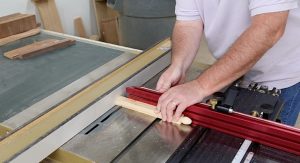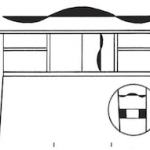We may receive a commission when you use our affiliate links. However, this does not impact our recommendations.
 As my article on building the Southern Gent’s Mirror Stand – in the August 2013 Popular Woodworking Magazine (issue #205) – passed through design and begin routing (being passed from editor to editor for each to read and mark corrections), my terminology was called into question.
As my article on building the Southern Gent’s Mirror Stand – in the August 2013 Popular Woodworking Magazine (issue #205) – passed through design and begin routing (being passed from editor to editor for each to read and mark corrections), my terminology was called into question.
“What are bump-cut tenons,” I was asked. As I explained that it’s a cut made at your table saw in which you slide the workpiece back and forth as you also move the workpiece over the blade being guided by a miter gauge, eyebrows were raised. The reply was that I used another “Huey-ism” in my article.
I’ll bet there is another term for this process, but I have been unable to find it, outside of it being a referred to as a “quick-cut” tenon. Below is a short video to show exactly what I am doing. If you can name that method, and can back it up with a reference, please do so. If you want to have some fun and try to develop a name for this process that catches on, that would be fine. But please let us know you made it up.
If after you watch the video you don’t think this method for you, we have a couple of inexpensive downloads of other table saw tenon jigs you can download. One is from me. It’s a jig I”ve used in my shop from the beginning. The second is Robert W. Lang’s jig that we use in the PWM shop.
Here are some supplies and tools we find essential in our everyday work around the shop. We may receive a commission from sales referred by our links; however, we have carefully selected these products for their usefulness and quality.








As a old “Normite” I can definitely say that he did a version of this back in the 1980’s. The main difference between you and him is that you use this for the entire process whereas Norm, following a quick series of saw blade passes on a tenon (not using a dado blade set up), would use the technique to clean off the in between pieces from the cuts and smooth off the tenon surface. It was nice to see this technique used for the entire tenon though.
Glen,
I learned a similar technique when I first bought my Shopsmith some 33 years ago. They actually have you nibble out the bulk of the waste then use the “bump” technique to smooth off the tenon. Back then, I had no idea that a shoulder plane existed, let alone owned one. Over the years, I have used the method off & on when I only had a couple of tenons to make. It also works for small dados if you set your stop blocks properly. A TV show put on by another magazine seems use this method fairly often.
My safety rules have been to make sure that the Miter Gauge is solid and supports the work close to the blade, the fence is properly set and the workpiece is small enough to handle with one hand.
A question for your consideration:
On wider pieces (say about 3″ or more) that might be more risky to move in & out over the blade, would a sanding block or Gripper make it better for moving the work piece back & forth when working on the flat sides? – Just a thought that popped into my head as I was writing this.
Dave
BTW, if you’re concerned that your miter gauge isn’t long enough for shorter pieces, you can build a fixture or add an extension to your miter gauge.
I’ve been doing that for years, after seeing Normie do something essentially similar on NYWS. I’ve never thought of it as a “bump” cut, but I did learn over the years of doing it that sliding the piece laterally across the blade like that while moving it back and forth helps make a smooth, flat side to the tenon, whereas just making a bunch of parallel cuts leaves a ridges surface that you then need to fine-tune with a shoulder plane or something. With the technique shown above, if you take your time and are sufficiently careful, you can pretty much end up with a tenon ready to be fit and glued.
I first observed this techniques13 years ago while taking a course by Chris Becksvoort taught at the Center for Furniture Craftsmanship in Maine. It was not actually part of the Shaker furniture design course but rather a technique I observed while watching Chris make presents (dovetail marking guides) for class participants. I have no idea whether there is an official name for the process but Chris referred to it as making “speed tenons.” That name made sense to me since one usually cuts tenon shoulders on the table saw and this process certainly “speeds” up creating tenons that are ready for clean up and fitting with a shoulder plane.
At first I was very concerned about the safety of the process but quickly learned a couple of simple steps that largely allayed those fears. First and foremost – make sure that the miter gauge securely supports the work piece from behind. Second, complete the majority if not all of the waste removal with nibbling. That way the “speed tenon” is doing nothing more than smooting out high spots. Finally, and this is largely a repeat of the first warning, don’t use speed tenoning on short work pieces. There simply will not be enough support from the miter gauge. As with all wood working, it’s generally a good idea to use your head for more than a place to hold a hat and a pair of safety glasses. If you aren’t comfortable with the technique, don’t do it.
Oh, no! Tell me I heard wrong. My favorite woodworking video instructor using that “word” that drives me crazy, “heigth”. Please tell be this was an aberration and not a new “Hueyism.”
You might want to read this article, which coincidentally appeared after another magazine suggested your “bump cut”
https://www.popularwoodworking.com/techniques/speed-tenons-safely